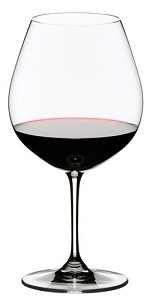Baco Noir (France)
Baco Noir is a French-American hybrid created by French botanist François Baco.
Baco Noir was bred to be phylloxera-resistant and easy to grow in cool climates.
Typical Flavors
can show a crescendo of flavors.
It can be vinified similar to Pinot Noir or to Cabernet Sauvignon.
Red Cherry |
Black Cherry |
Blueberry |
Raspberry |
Blackberry |
Black Currant |
Ripe Plum |
Herbs |
Oak added Flavors:
Vanilla |
Coffee |
Spices |
Tobacco |
Flavors of Black Fruits, Ripe Plum and Earth are the most common flavors.
Oaked wines will have added notes of Smoke, Chocolate, and Spicy Finish and will taste more robust and rustic.
Profile
Baco Noir has low tannins and good acidity:
| BODY | Light to medium | ||
| TANNINS | Low | ||
| FRUIT | Medium - High | ||
| ACIDITY | High | ||
| |||
Food Pairing
Antipasti |
Salami |
Ham |
Soups |
Lasagna |
Mushroom |
Risotto |
Truffle |
Pizza |
Sandwitch |
Hamburger |
Chili |
Goose |
Duck |
Rabbit |
Pork |
Baco Noir is food friendly and can be paired with a wide variety of dishes, especially grilled or roasted white meat.
Pairing Suggestions
Excellent Pairing:
Charcuterie. Lasagna. Rich Pizza.
Mushroom. Truffle. Mushroom Risotto.
Poultry. Turkey. Duck. Goose. Pheasant.
Grilled. Roasted White Meat.
Grilled Pork. Ham. Bacon.
Hearthy Soups. Braised Beef. Beef Stews.
BBQ. Burgers. Spare Ribs.
Aged Cheese:
Comté. Goat.
If You Like
You Will Also Like:
The Ideal Glass

The Burgundy glass is perfect for a light and fruity red wine.
The glass is broader than other red wine glasses.
The larger bowl has the function of accumulating the aromas of delicate red wines. It also allows a proper swirling, channeling aromas upward.
In addition, the style of the glass directs the wine to the tip of your tongue
for a better reception of the tastes.
About Baco Noir
Baco Noir is a hybrid grape variety, which means a offspring of two varietals that belong to different Vitis species.
Baco Noir was first bred in France by Francois Baco (1865-1947), hence the name, at the end of 1800, during the phylloxera plague epidemic.
Baco Noir is a cross between Folle Blanche (Vitis Vinifera) and a native North American Vitis Riparia grape variety.
Described as a meatier Pinot Noir or a ready to drink Cabernet Sauvignon, it was bred to be phylloxera-resistant.
The berries are small with black skin, giving a very dark color to the wines.
High acidity, like Riesling, typical of the cold climates and low tannins call for the support of oak.
Many undergo Carbonic Maceration (like Beaujolais) to emphasize the fruity style.
The main issues with Baco Noir are the high yields and the undesirable foxy aroma (earthy and sweet muskiness).
Aging
Most Baco Noirs should be drunk after releasing (drink me soon style).
Oaked Baco Noirs improve much after 5 years. Best examples 10 years.
Suggested to decant one hour before serving.
Baco Noir in North America
The ability to withstand harsh cold, made it popular in northeastern U.S. and Canada in the 1950s.
This resistance makes it a favorable alternative to growing Pinot Noir (the hardest grape to grow).
Today it is grown everywhere from Nova Scotia to Oregon, from the Great Lakes Region (Michigan, New York, Ontario) to Colorado.
In Ontario, Central Canada, it is the most widely planted grape and known for the good quality (Ontario's Signature Grape).